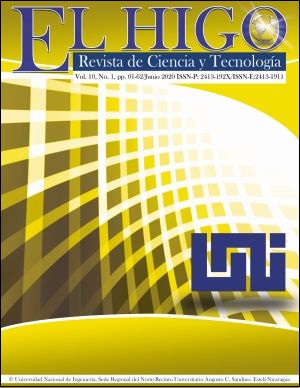Physicochemical evaluation of the dairy obtained from the pasteurized fresh cheese produced in the dairy process workshop in the Espam “MFL”
DOI:
https://doi.org/10.5377/elhigo.v10i1.9921Keywords:
Whey, Milk drink, probioticsAbstract
Milk serum or whey is a liquid by-product obtained from the coagulation of milk during cheese making. It constitutes an economic source of protein, which gives multiple properties in many foods. Varieties of nutritional uses of this by-product have been demonstrated through many researches, determining that it is more profitable to use it than to discard it. The objective of this research was to evaluate the physical-chemical composition of the whey produced from the production of fresh pasteurized cheese produced in the dairy process in the area of the ESPAM "MFL", in order to certify that it is significant for its use as a substance Food grade in the formulation of fermented milk drinks or other dairy products. The milk used as raw material was subjected to a previous physical-chemical analysis, determining total solids (ST), pH, titratable acidity (AT), density and according to what is established in the Ecuadorian Technical Standard INEN 2594. Physical characterization -whey chemistry consisted of the determination of total solids (ST), pH, titratable acidity (AT), fat, proteins, density and the determination of lactose and minerals (LM) was performed by analytical difference. The values obtained were statistically analyzed using the SPSS statistical package. The results obtained for the whey classify it as sweet whey, with excellent nutritional characteristics and important to be used in food technology for the production of dairy drinks fermented with probiotics, protein supplements, among other applications.
Downloads
2170
Downloads
Published
How to Cite
Issue
Section
License
Todo el material publicado en la revista se comparte bajo la Licencia Creative Commons Attribution-NonCommercial-NoDerivatives 4.0., se permite la copia y redistribución del material en cualquier medio o formato siempre y cuando se de crédito de forma explícita a la revista, el autor y la obra, se distribuya de forma gratuita y sin hacer modificaciones al contenido.







 Universidad Nacional de Ingeniería, Sede Regional UNI Norte. Entrada a La Tunoza, Antigua Hacienda el Higo. Estelí – Nicaragua.
Universidad Nacional de Ingeniería, Sede Regional UNI Norte. Entrada a La Tunoza, Antigua Hacienda el Higo. Estelí – Nicaragua. Tel. (505)86967849, (505) 84143047, (505) 89663120
Tel. (505)86967849, (505) 84143047, (505) 89663120